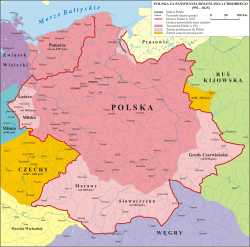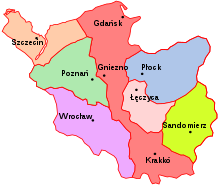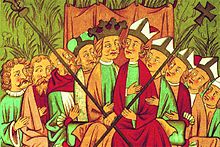Kingdom of Poland
Kingdom of Poland | |||||||||
|---|---|---|---|---|---|---|---|---|---|
| 1025–1385 | |||||||||
 Kingdom of Poland in 1025 | |||||||||
 Kingdom of Poland in 1370 | |||||||||
| Capital | |||||||||
| Official languages | Polish, Latin | ||||||||
| Religion |
| ||||||||
| Demonym(s) | Polish | ||||||||
| Government | Hereditary Feudal monarchy | ||||||||
| Historical era | Middle Ages | ||||||||
| Currency | |||||||||
| |||||||||
The Kingdom of Poland (Polish: Królestwo Polskie; Latin: Regnum Poloniae) was a monarchy in Central Europe during the medieval period from 1025 until 1385.
Background
[edit]The West Slavic tribe of Polans who lived in what is today the historic region of Greater Poland, gave rise to a state in the early 10th century, which would become the nascent predecessor of the Kingdom of Poland. Following the Christianization of Poland in 966, and the emergence of the Duchy of Poland during the rule of Mieszko I, his eldest son Bolesław I the Brave inherited his father's dukedom and subsequently was crowned as king.[1]
History
[edit]Establishment
[edit]
In 1025, Bolesław I the Brave of the Piast dynasty was crowned as the first King of Poland at the cathedral in Gniezno and elevated the status of Poland from a duchy to a kingdom after receiving permission for his coronation from Pope John XIX.[2] Following the death of Bolesław, his son Mieszko II Lambert inherited the crown and a vast territory after his father, which included Greater Poland (with Mazovia), Lesser Poland, Silesia, Pomerania, Lusatia, Moravia, Red Ruthenia, and Upper Hungary. However, in 1031, he was forced to renounce the title and flee the country when a series of peasant uprisings broke out in what became known as the pagan reaction,[3] and Yaroslav I the Wise, the Grand Prince of Kiev, invaded the country from the east while Mieszko II was in Lusatia fighting the Holy Roman Emperor, Condrad II. Yaroslav I installed his ally, the half-brother of Mieszko II, Duke Bezprym, as the ruler of Poland. However, as a result of the upheavals, the kingdom suffered territorial losses and was effectively reduced to a duchy.
Casimir I the Restorer managed to reunite parts of the kingdom following the crisis and moved the capital to Kraków. However, he failed to reinstitute the monarchy due to opposition from the Holy Roman Emperor.[4] In 1076, Bolesław II the Bold, with the support of Pope Gregory VII, regained the royal crown but was later excommunicated and banished from the kingdom in 1079 for murdering his opponent, Bishop Stanislaus of Szczepanów. In 1079, Władysław I Herman, who never pursued kingship took over the reins after the expulsion of Bolesław II. Władysław I was disinterested in becoming king and the country was effectively run by wojewoda Sieciech.
Feudal fragmentation
[edit]
In 1102, Bolesław III Wrymouth became the ruler of Poland.[5] Unlike Władysław I, Bolesław III proved to be a capable leader who restored the full territorial integrity of Poland but ultimately was not able to obtain the royal crown due to continued opposition from the Holy Roman Empire. Upon his death in 1138, the country was divided between his sons into the duchies of Greater Poland, Lesser Poland, Masovia, Silesia, Sandomierz, and a Pomeranian vassal. As a result, Poland entered a period of feudal fragmentation that lasted for over 200 years.
During the first half of the 13th century, the Silesian Piasts attempted to restore the kingdom. Henry the Bearded undertook efforts to reunite the fragmented duchies through a combination of political maneuvering and conquest. He also undertook efforts towards the coronation of his son, Henry II the Pious, and negotiated with other Polish dukes and the Holy Roman Emperor, Frederick II of Hohenstaufen, to this end. Henry II, continued his father's efforts, but the first Mongol invasion in 1241 and his death at the Battle of Legnica, abruptly ended the unification.[6] Generally, most Polish scholars agree that if not for the Mongol invasions of Poland, the kingdom would have been restored in the middle of the 13th century, under the Silesian Piast Dynasty.
Reunited kingdom
[edit]

The next attempt to restore the monarchy and unify the Polish kingdom would occur in 1296, when Przemysł II was crowned as the King of Poland in Gniezno. The coronation did not require papal consent as the title of king was already instituted in 1025. However, his reign was short-lived, as he was murdered by assassins sent by the margraviates of Brandenburg. After the killing of Przemysł II, next to take the title of king was Wenceslaus II of Bohemia from the Czech Přemyslid dynasty, who reigned until 1305.[7] Following a vacancy that lasted until 1320, the Kingdom of Poland was fully restored under Władysław I the Elbow-High, who was crowned at the Wawel cathedral in Kraków, and then subsequently strengthened by his son Casimir III the Great, who expanded into Red Ruthenia. However, he had to renounce his claims to Silesia in order to secure peace with the Holy Roman Empire. Casimir III is the only Polish king to receive the title "Great", and his reign was marked by substantial developments in the kingdom's urban infrastructure, civic administration, and military strength. After his death on 5 November 1370, the rule of the Piast dynasty would come to an end.
Following the death of Casimir III, who died without an heir, Louis I of Hungary from the House of Anjou became king in 1370. The period of his transitional rule also marked the rise of the nobility in the political life of the country. When Louis I died in 1382, his daughter Jadwiga took over the throne as King of Poland. Her advisors negotiated with Jogaila of Lithuania, concerning a potential marriage to Jadwiga. Jogaila pleaged to convert to Christianity and signed the Union of Krewo in 1385. The agreement also heralded a change in the legal status of the Polish realm to that of a Crown of the Kingdom of Poland, which was a political concept that assumed unbroken unity, indivisibility and continuity of the state. According to this concept, the Kingdom of Poland ceased to be the patrimonial property of a monarch or dynasty, and became a common good of the political community of the Polish kingdom. After the conclusion of the union, Queen Jadwiga married Grand Duke Jogaila, who was crowned as King Władysław II Jagiełło on 4 March 1386, an event that marked the beginning of the Jagiellon dynasty.[8]
See also
[edit]- List of Polish monarchs
- History of Poland in the Middle Ages
- Culture of medieval Poland
- History of Poland
References
[edit]- ^ Urbańczyk, Przemysław (2017). Bolesław Chrobry – lew ryczący (in Polish). Toruń: Wydawnictwo Naukowe Uniwersytetu Mikołaja Kopernika. pp. 308–309. ISBN 978-8-323-13886-0.
- ^ Urbańczyk, Przemysław (2017). Bolesław Chrobry – lew ryczący (in Polish). Toruń: Wydawnictwo Naukowe Uniwersytetu Mikołaja Kopernika. pp. 309–310. ISBN 978-8-323-13886-0.
- ^ Krajewska, Monika (2010). Integracja i dezintegracja państwa Piastów w kronikach polskich Marcina Kromera oraz Marcina i Joachima Bielskich (in Polish). Warszawa (Warsaw): W. Neriton. p. 82. ISBN 978-83-909852-1-3.
- ^ "Casimir I". Encyclopedia Britannica. 2023. Retrieved 8 January 2024.
As ruler of Poland, however, he was never crowned king, and German suzerainty over Poland was in fact reestablished during his reign.
- ^ Jasiński, Kazimierz (2004). Rodowód pierwszych Piastów (in Polish). Poznań: Wydawnictwo PTPN Mikołaja Kopernika. pp. 185–187. ISBN 83-7063-409-5.
- ^ Oskar, Przemysław (2000). Borderlands of Western Civilization: A History of Central Europe. Safety Harbor, FL: Simon Publications. p. 87. ISBN 9780826037404.
- ^ Ożóg, K. (1999). Piastowie, Leksykon biograficzny. Kraków: Simon Publications. p. 159. ISBN 83-08-02829-2.
there are no preserved information about a papal consent for the coronations of Wenceslaus II in 1300 and Ryksa-Elisabeth in 1303.
- ^ Halecki, Oscar (1991). Jadwiga of Anjou and the Rise of Central Europe. Polish Institute of Arts and Sciences of America. pp. 116–117, 152. ISBN 978-0-88033-206-4.


